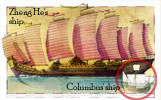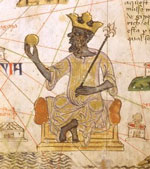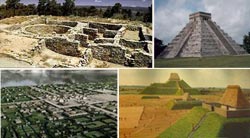|
Digital
History>eXplorations>The
World Before 1492
Teacher
Resources
This
page contains specific resources developed for teachers using
this Exploration.
Entire
Unit | History Quiz | Zheng
He | Timbuktu | Cahokia
Focusing
Event for Entire Unit:
Brainstorm
with the class things they know about ancient civilizations
(location, religious beliefs, rituals, artifacts, contributions)
This
can be done in multiple ways:
1.
Sticky notes with students writing individually on a limited
number of post-it notes, categorizing, posting with others
eventually contributing to a class fact storming map
2. Inspiration Software: electronic concept map
3. Chalkboard, whiteboard
4. Preprinted graphic organizers to fill in
Back
to Top
Exploration
1: Check Your Knowledge
Accessing
Prior Knowledge
1. Ask the students to take a few minutes and see how many
questions they can answer on the Check
Your Knowledge tab. You could first treat the
questions as a non-graded pop quiz (5 -7 minutes)
and spend most of
the time discussing the answers (opens
in a new window). Pay close attention to the closing statement
and use it
as a rationale for doing the exploration.
2.
You could also allow students to find the answers using
key websites.
Resources
for Inventions and Inventors
Back
to Top Back
to Top
Exploration
2: Zheng He
Focusing Event:
 Look
at the pictures of the two ships on the Zheng
He exploration page or click the picture to the left. Look
at the pictures of the two ships on the Zheng
He exploration page or click the picture to the left.
Without
any directions, have your students make predictions about
the ships. Who sailed these ships? Which ship was older?
Which ship was part of a larger fleet? What country was
each ship from? What is the same about the ships and what
appears different? As the students to justify their predictions
(What clues guided their predictions? Are their predictions
based on prior knowledge?).
Read
as a class the Essential Questions and then allow the students
to do some investigating on their own. They should read
the selections and follow a few of the links provided in
order to be able to complete one of the “Extending
the Investigation” activities.
Extending
the Investigation:
1.
Using the resources below and this printed map, trace the
voyages of Zheng He in one color and then use another color
to draw the explorations of some of the other early explorers
(before 1492). Compare and contrast their voyages. Why do
you think the Chinese halted their explorations?
(Outside
links will open in a new window; close that window to
return
to
this page)
Map
Age of Discovery
http://www.lib.utexas.edu/maps/historical/shepherd/
explorer_map_shepherd.jpg
Hispanic
exploration
http://www.neta.com/~1stbooks/0dchron.htm
The
Age of Exploration Timeline
http://www.mariner.org/educationalad/ageofex/
2.
From what you learned about the Chinese culture and explorations
of Zheng He, what do you think life would have been like
here in the United States if Zheng He discovered America
before Columbus? Write a brief description of the differences
you would expect to find in America today if the Chinese
discovered America. Write this description as if it were
a diary entry.
3.
Investigate the reasons for exploration and discovery. Compare
and contrast the differences in rationale between the Spanish,
Portuguese, English, Chinese and other cultures. Why did
some opt to turn xenophobic while others wanted chose to
conquer the world? Is it political? Religious? Cultural?
(Links
will open in a new window; close that window to return to
this page)
European
voyages
http://www.ucalgary.ca/applied_history/tutor/eurvoya/columbus.html
Back
to Top
Exploration
3: Timbuktu
Focusing
Event:
 |
Spend
some time looking at the image on the Timbuktu
Exploration page or click the picture. Ask the students
to analyze what they see in the picture (for example…writing
in another language, a king with a crown, a scepter,
water, a gold ball etc).
Make
predictions about this image. What cultural influences
do you see? What would you guess the significance of
the image might be? Now introduce the students to the
ancient civilization of Timbuktu. |
Extending
the Exploration:
1.
Using the map resources
websites on the Timbuktu Exploration page, locate Timbuktu
on a map and describe its geographical setting and historical
significance.
2.
Using the Mansa
Musa resources websites listed on the Tibuktu exploration
page, identify Mansa Musa and explain his historical significance
as you create a biography page for a book called “Famous
Kings and their contributions”.
3.
Identify the kingdoms that flourished in this region and
the trade that Timbuktu took part in.
4.
Take a look at the
History Channel timeline
http://www.history.com/classroom/unesco/timbuktu/timeline.html
and
examine the major events in Timbuktu’s history
and compare them to what was going on in the rest of
the world. What
do you think led
to Timbuktu’s rise and fall? Create a Multimedia
presentation that points out the important historical
events that lead
to Timbuktu’s rise and fall.
5.
Using the resources on the Timbuktu
Exploration page, imagine that you are traveling with
Mansa Musa on the road to Mecca. Describe the pilgrimage
in a letter to your parents including what you see, hear
and experience along the road. What was the significance
to you of this pilgrimage?
Back
to Top
Exploration
4: Cahokia
Focusing
Event: Ancient Civilizations in the Americas
 |
Ask
students to look at the images at the beginning
of the Cahokia Exploration and try to place them.
These are all images of different ancient ruins (or graphic
replicas) of ancient civilizations in the Americas. What
appears similar or different about these? |
Extending
the Exploration:
1.
Use a software program like Timeliner by
Tom Snyder
http://www.teachtsp.com/products/product.asp?SKU=TIMV50&Subject=SocialStudies
or Inspiration
http://www.inspiration.com/home.cfm
to create a timeline which maps the Aztec, Mayan, ancestral
Puebloans and Cahokia civilizations. Include important
features of the civilization and even images of
artifacts found at
these ruins.
2.
Compare the different cultures of the ancient American civilizations.
What were the similarities and differences in religious
beliefs, cultural contributions, rituals, and extinction
of these primitive people? You can either make these comparisons
in a presentation format, webpage, or use the Civilization
Comparison Worksheet (Microsoft Word format).
Resources
Teacher
Video Resources are available on United Streaming
http://streaming.discoveryeducation.com/
and there
is a 30 day trial membership available.
These
are the video clips from United Streaming that could be
referenced.
- Great
Age of Exploration (1400-1550), The (30:55) FULL VIDEO
- The
Great Age of Exploration: Part One (12:57)
- The
World in 1400 (01:13)
- The
Renaissance (02:18)
- Trade
with the Far East (02:57)
- Prince
Henry the Navigator (01:53)
- The
Shipyards of Portugal (01:23)
- Exploring
the Coasts of Africa and India (00:49)
- The
Slave Trade (00:27)
- The
Voyages of Columbus (01:49)
- The
Great Age of Exploration: Part Two (13:11)
- Columbus's
First Voyage 1492-1493 (02:12)
- Columbus's
Later Voyages (01:27)
- The
Conquests of Mexico and Peru (01:51)
- Exploration
and Colonization (02:09)
- Assessing
the Great Age of Exploration (01:08)
- Video
Quiz: The Great Age of Exploration (02:42)
Back
to Top
|
